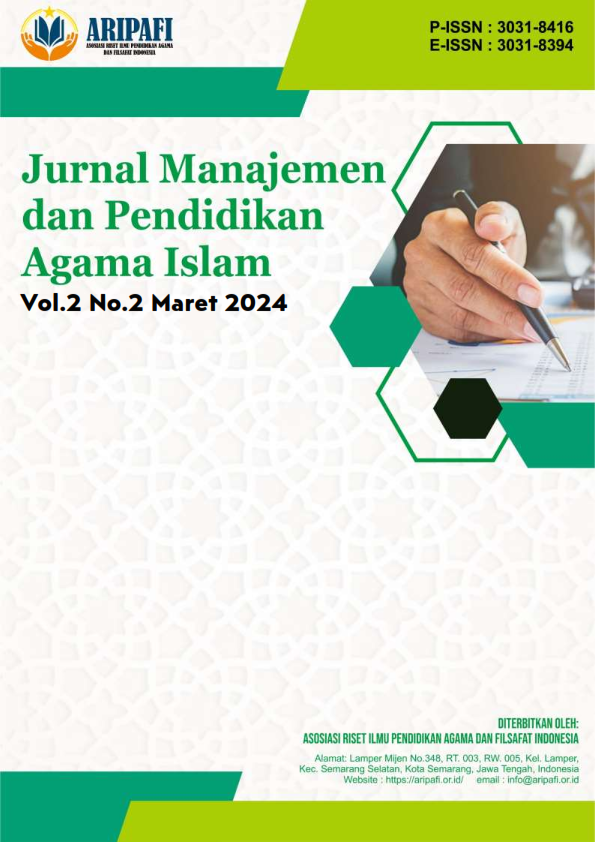Hukum Islam Antara Idealisme Dan Realitas
DOI:
https://doi.org/10.61132/jmpai.v2i2.167Keywords:
Islamic Law, Idealism and RealityAbstract
The study discussed in this study is a library study that seeks to present descriptively with methods of qualitative and library research, i.e. library-based research, in the process of data collection, researchers conduct research and analyze library sources obtained from the theories of literary books. (library research). The result of the study of the library obtained there was a gap between the desired idealism and the reality in its implementation; 1) Islamic law idealism offers principles that are fair, fair, and based on Islamic moral values. However, in the reality of its implementation, there are challenges that result in the gap between such idealism and reality. Factors such as varied social, political, cultural, and interpretation of Islamic teachings affect the gap between idealism and the reality of the Islamic law. These factors can hinder the implementation that corresponds to the desired idealism. 3) The impact of the gap between idealism and the reality of Islamic law is visible in societies, where there is sometimes an inconsistency between public expectations of fair implementation and realities that do not meet those expectations. This can lead to dissatisfaction, injustice, and social tension. 4) To overcome this gap, efforts involving various parties are needed, including religious leaders, Islamic law scholars, legal practitioners, and the general public. In this regard, a deeper understanding of Islamic teachings, the strengthening of justice institutions, the involvement of society in the process of law-making, and the promotion of dialogue and understanding between groups can be effective measures. Building understanding and cooperation between religious leaders, Islamic law scholars, and legal practitioners with the general public is key in strengthening the implementation of Islamic Law in accordance with desired idealism. It is essential for the implementation of Islamic law to justice, sustainability, and well-being for society.
Downloads
References
Basettu, Baharuddin. “Konflik Dan Ketenangan Dalam Hukum Islam Antara Idealisme Dan Realisme.” Al-Bayyinah 1, no. 2 (2017): 29–42. https://doi.org/10.35673/al-bayyinah.v1i2.15.
Danial. Syariat Islam Dan Wajah Kekerasan: Studi Bentuk, Penyebab, Dan Upaya Penanggulangan Kekerasan di Aceh. Edited by Az-Zahra Media Society. Az-Zahra Media Society. 1st ed. Vol. 1. Lhokseumawe: Az-Zahra Media Society, 2023.
HAMZAH. “Konflik Dan Ketegangan Dalam Hukum Islam: Idealisme Dan Realisme.” Stadium 1, no. 1 (2017): 1–22.
Hukom, D A. “Negara Islam Sebagai Sebuah Idealisme Yang Harus Berhadapan Dengan Realitas Kehidupan Di Bumi Nusantara.” Jurnal Islam Nusantara 03, no. 02 (2019): 389–416. http://www.jurnalnu.com/index.php/as/article/view/143.
Maula, Bani Syarif. “Realitas Hukum Islam Dalam Konfigurasi Sosial Dan Politik Di Indonesia (Perspektif Sosiologi Hukum Tentang Perkembangan Hukum Islam Di Indonesia).” - 2, no. 2 (2003): 247.
Rusdi. “Filsafat Idealisme (Implikasinya Dalam Pendidikan).” Jurnal Dinamika Ilmu 13, no. 2 (2013): 291–306. https://doi.org/10.21093/di.v13i2.70.
Yusuf, Anwar Sofiyudin, and Universitas. “AKAR PEMIKIRAN REALISME DALAM HUKUM ISLAM.” Universitas Islam Negeri Syarif Hidayatullah 1, no. 1 (2007): 182. http://digilib.unila.ac.id/4949/15/BAB II.pdf.
Abdul Ghani Abdullah, Pengantar Kompilasi Hukum Islam dalam Tata Hukum Indonesia Jakarta, Gema Insani Press, 1994.
Ali, Muhammad Daud, Hukum Islam Pengantar Ilmu Hukum dan Tata Hukum Islam di Indonesia, Jakarta: PT Raja Grafindo Persada, 2006.
Ash-Shiddieqy, Hasbi, Peradilan dan Hukum Acara Islam, Yogyakarta: Al-Ma’arif, 1964.
Coulsin, Noel J, “Doctrine and Practice in Islamic law”, Bulletin of the School of Oriental and African Studies, London: University of London, 1956,
-------, dalam artikelnya “The State and the Individual in Islamic Law,” Internaional and Comparative Law Quarterly, Januari 1957.
-------, Conflict and Tensions in Islamic Jurisprudence, (selanjutnya disebut Conflict) Chicago: The Unversity of Chicago Press, 1969.
Dahlan Idhamy, Karakteristik Hukum Islam, Jakarta, Media Sarana Press, 1987
Departemen Pendidikan Dan Kebudayaan, Kamus Bahasa Indonesia, cet. Ketiga, Jakarta: Balai Pustaka, 1990.
Departemen Agama RI, Pendidikan Agama Islam Pada Perguruan Tinggi Umum, Jakarta: Direktorat Jenderal Kelembagaan Agama Islam, 2001.
Espito, John L., Ensiklopedi Oxford Dunia Islam, jilid 6, cet. Kedua, Bandung: Mizan, 2002.
George, Ritzer, Sociological Theory, Toronto: The McGraw-Hill Company Inc, 1996.
Ghandur, El, Perspektif Hukum Islam, penerjemah Ma’mun Muhammad Murai, Yogyakarta: Pustaka Fahima, 2006.
Hamdan Mansoer, dkk, Materi Instruksional Pendidikan Agama Islam, Jakarta: Direktorat Perguruan Tinggi Agama Islam, 2004.
Hanbal, Ahmad bin, Musnad Imam Ahmad, Hadis Abu Bardah bin Niyar, (Maktabah al-Hadis), hadis No. 15462.
Hasby Asy-Shidiqiy, Falsafah Hukum Islam, Yogyakarta Bulan Bintang 1975.
Ilyas, Muhtarom. Pendidikan Agama Islam, Jakarta, PT. Gramedia Widiasarana Indonesia, 2009
Mudafir, Ali, Teori Dan Aliran Dalam Filsafat Dan Teologi, Yogyakarta: Gadjah Mada Press, 1996.
Nasution, Harun, Islam Ditinjau dari Berbagai Aspeknya, Jakarta: UI-Press, 1985.
Pramudya, Willy, Cak Munir, Engkau Tak Pernah Pergi, Jakarta: GagasMedia 2004
Qardhawi, Yusuf, Al-Islam wal ilmaniyyah wajhan li wajhin, terj. Amirullah Kandu, Islam dan Sekulerisme, Bandung: CV. Pustaka Setia, 2006.
Sabiq, Sayyid, Fiqh Sunnah, jilid 2, Semarang: Toha Putra, Pt.
Syahrur, Muhammad, Prinsip dan Dasar Hermeneutika Hukum Islam Kontemporer, cet. Kedua, Yogyakarta: Sukses offset, 2007.
Downloads
Published
How to Cite
Issue
Section
License
Copyright (c) 2024 Jurnal Manajemen dan Pendidikan Agama Islam

This work is licensed under a Creative Commons Attribution-ShareAlike 4.0 International License.





